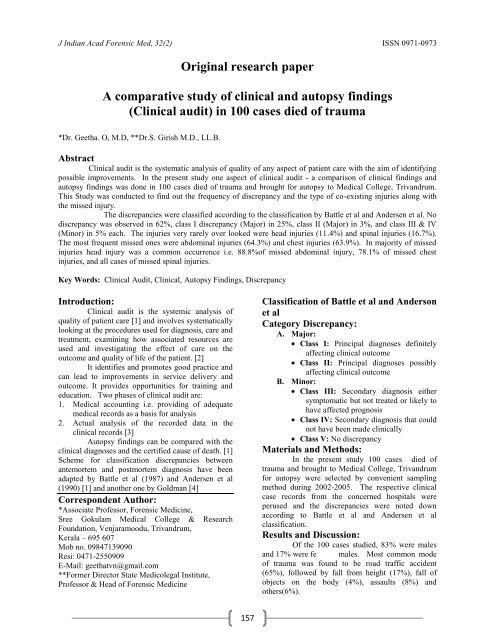jiafm, 2010-32(2) april-june. - forensic medicine
jiafm, 2010-32(2) april-june. - forensic medicine
jiafm, 2010-32(2) april-june. - forensic medicine
- No tags were found...
You also want an ePaper? Increase the reach of your titles
YUMPU automatically turns print PDFs into web optimized ePapers that Google loves.
J Indian Acad Forensic Med, <strong>32</strong>(2) ISSN 0971-0973Original research paperA comparative study of clinical and autopsy findings(Clinical audit) in 100 cases died of trauma*Dr. Geetha. O, M.D, **Dr.S. Girish M.D., LL.B.AbstractClinical audit is the systematic analysis of quality of any aspect of patient care with the aim of identifyingpossible improvements. In the present study one aspect of clinical audit - a comparison of clinical findings andautopsy findings was done in 100 cases died of trauma and brought for autopsy to Medical College, Trivandrum.This Study was conducted to find out the frequency of discrepancy and the type of co-existing injuries along withthe missed injury.The discrepancies were classified according to the classification by Battle et al and Andersen et al. Nodiscrepancy was observed in 62%, class I discrepancy (Major) in 25%, class II (Major) in 3%, and class III & IV(Minor) in 5% each. The injuries very rarely over looked were head injuries (11.4%) and spinal injuries (16.7%).The most frequent missed ones were abdominal injuries (64.3%) and chest injuries (63.9%). In majority of missedinjuries head injury was a common occurrence i.e. 88.8%of missed abdominal injury, 78.1% of missed chestinjuries, and all cases of missed spinal injuries.Key Words: Clinical Audit, Clinical, Autopsy Findings, DiscrepancyIntroduction:Clinical audit is the systemic analysis ofquality of patient care [1] and involves systematicallylooking at the procedures used for diagnosis, care andtreatment, examining how associated resources areused and investigating the effect of care on theoutcome and quality of life of the patient. [2]It identifies and promotes good practice andcan lead to improvements in service delivery andoutcome. It provides opportunities for training andeducation. Two phases of clinical audit are:1. Medical accounting i.e. providing of adequatemedical records as a basis for analysis2. Actual analysis of the recorded data in theclinical records [3]Autopsy findings can be compared with theclinical diagnoses and the certified cause of death. [1]Scheme for classification discrepancies betweenantemortem and postmortem diagnosis have beenadapted by Battle et al (1987) and Andersen et al(1990) [1] and another one by Goldman [4]Correspondent Author:*Associate Professor, Forensic Medicine,Sree Gokulam Medical College & ResearchFoundation, Venjaramoodu, Trivandrum,Kerala – 695 607Mob no. 09847139090Resi: 0471-2550909E-Mail: geethatvn@gmail.com**Former Director State Medicolegal Institute,Professor & Head of Forensic MedicineClassification of Battle et al and Andersonet alCategory Discrepancy:A. Major:Class I: Principal diagnoses definitelyaffecting clinical outcomeClass II: Principal diagnoses possiblyaffecting clinical outcomeB. Minor:Class III: Secondary diagnosis eithersymptomatic but not treated or likely tohave affected prognosisClass IV: Secondary diagnosis that couldnot have been made clinicallyClass V: No discrepancyMaterials and Methods:In the present study 100 casesdied oftrauma and brought to Medical College, Trivandrumfor autopsy were selected by convenient samplingmethod during 2002-2005. The respective clinicalcase records from the concerned hospitals wereperused and the discrepancies were noted downaccording to Battle et al and Andersen et alclassification.Results and Discussion:Of the 100 cases studied, 83% were malesand 17% were fe males. Most common modeof trauma was found to be road traffic accident(65%), followed by fall from height (17%), fall ofobjects on the body (4%), assaults (8%) andothers(6%).157



![syllabus in forensic medicine for m.b.b.s. students in india [pdf]](https://img.yumpu.com/48405011/1/190x245/syllabus-in-forensic-medicine-for-mbbs-students-in-india-pdf.jpg?quality=85)



![SPOTTING IN FORENSIC MEDICINE [pdf]](https://img.yumpu.com/45856557/1/190x245/spotting-in-forensic-medicine-pdf.jpg?quality=85)

![JAFM-33-2, April-June, 2011 [PDF] - forensic medicine](https://img.yumpu.com/43461356/1/190x245/jafm-33-2-april-june-2011-pdf-forensic-medicine.jpg?quality=85)



![JIAFM-33-4, October-December, 2011 [PDF] - forensic medicine](https://img.yumpu.com/31013278/1/190x245/jiafm-33-4-october-december-2011-pdf-forensic-medicine.jpg?quality=85)


